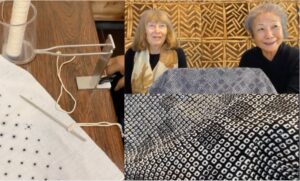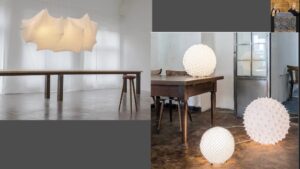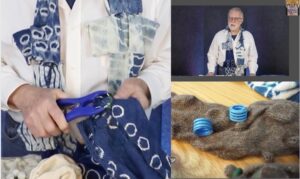“Conversations with Cloth: Shibori connecting the World” by Eva-Maria Spampinato
March 10, 2021
Slow Fiber Studios is returning with Conversations with Cloth online program, Series TWO: connecting Japanese shibori tradition with the world from the Americas, Africa, Southeast Asia to Southwest China. Esteemed artists and curators Yoshiko Iwamoto Wada and Ana Lisa Hedstrom, use shibori as a common language to decipher dyed patterns to reveal memories and varied cultural landscapes.

Episode 1: Bound-Resist: Ana Lisa Hedstrom and Yoshiko Iwamoto Wada, 2021.
Episode 1: Bound-Resist: American Tie-dye, Kumo, Miura, Kanoko Shibori, features “bound-resist” continuing from the 7th to the 21st century including innovative adaptations in North America. Yoshiko and Ana Lisa highlight how artisans and artists demonstrate resourcefulness for production methods and efficiency against the influx of sociocultural influences. This episode narrates the evolution of traditional shibori technology to the contemporary among fashion designers and artists capturing the sculptural potential through continual dialogue with materials and sustainable practices.
History of Bound-Resist Shibori, Japan
The earliest bound-resist textile fragments are found among the treasures of the Horyuji Temple, in Nara, Japan (607 AD). The early artifact examples reflect the influence from trade connecting to the Silk Road.

Episode 1: Bound-Resist: Top Left: Gigaku Sosoku textile fragment; Bottom Left: fragment detail, 7th Century, treasures of the Horyuji Temple, Collection of the Tokyo National Museum; Right: Replicated Gigaku Sosoku skirt commission by Hiroshi Murase, lightweight silk. Naturally dyed: yellow is an amur cork tree & over dyed with indigo for the green, Arimatsu, Japan, 2020.
In 2020, the Tokyo National museum commissioned Hiroshi Murase, an Arimatsu shibori artisan, to replicate a Gigaku Sosoku skirt, remnants found at Horyuji Temple. In a series of replications, the museum aims to reenact the making process for its original appearance to help us appreciate the ancient culture.
Historically, sumptuary laws curved luxury consumptions by various classes to keep social order. Expensive shibori processes were recreated with simpler or cheaper versions, which attest artisan ingenuity. Arimatsu artisans are no exception, who are known to devise simple tools to help produce alternative products.

Episode 1: Bound-Resist: Hiroshi Murase demonstrating how to make Kumo shibori, stainless steel hook, bobbin, string and fabric; 3D Kumo horns; Kumo shibori design, 2019.
There are many bound-resist variations, one of the first appeared in Arimatsu is kumo shibori, which resembles spider web. Radiating pleating needs a hook holding a point with appropriate tension, bound and wrapped. This deceptively simple method can create multiple designs and has become a signature shibori technique.

How to make Miura illustration from ‘Shibori: The Inventive Art of Japanese Shaped Resist Dyeing”, p. 71 by Yoshiko Wada, Mary Kellogg Rice, and Jane Barton, 1983; Episode 1: Bound-Resist; Yoshiko Wada and Ana Lisa Hedstrom discussing how miura design is made, memory on cloth.
Miura shibori is a continuous binding of loops held by tension. Artisans negotiate the tension using a hook to pluck fabric, loop the binding thread, and then cinch together. Once mastered, the technique is rapid making a less costly yet the pattern can mimic expensive kanoko shibori.

Episode 1: Bound-Resist: Yoshiko Wada and Ana Lisa Hedstrom discussing how kanoko shibori is made using stainless steel tools, designed by Hiroshi Murase, and textile design juxtaposed.
Kanoko shibori evokes the spotted baby deer, called ‘fawn dots’ and favored by ladies in Imperial Court during the Heian Period (794-1185). Originally produced in Kyoto by skilled artisans, was a luxury item often subject to sumptuary laws. Arimatsu shibori traditions from the early 17th century responded to the markets therefore produced the popular items using tools such as hooks and pins.

Episode 1: Bound-Resist: Yoshiko Wada and Ana Lisa Hedstrom speak about Suzusan’s miura textile lampshades.
Fusing traditional skills and contemporary product design is challenging. A recent story of Suzusan, a fifth-generation Artimatsu artisan family, succeeded in designing lampshades based on bound-resist keeping their 3D shapes. A washable, fabric shade with texture is enhanced by light, opens a new appreciation for handcrafts and sustainable design. This method is similar to Issey Miyake and Junichi Arai using polyester and heat to create permanent textures. All Suzusan products are handmade in Arimatsu, Japan.
Shibori 20th Century: N. American
North America’s counterculture movement and craft revival was reflected among fashion and music with iconic tie-dye during the 1960s-70. Where did this fascination come from?
Courtenay Pollack created his technique based on folding, clamping, tying and dyeing with multiple colors, called “Geometriart”. In 1969, Bill Graham commissioned a series of stage backdrops for Grateful Dead concerts. Courtenay’s vibrant psychedelic creations continue to mesmerize the 21st century.

Episode 1: Bound-Resist: Left: Courtney Pollock tie-dye backdrop for the Grateful Dead; Right: Carter Smith K Dress 1995, bias cut dress, georgette, dyes.
Carter Smith, in pursuit of creativity, began tie-dyeing in the 1960s. Later, his kaleidoscope-like colorful fabric finds an audience in the artwear movement. He designed elegant dresses with bias cut using georgette and chiffon to allow dyes to move within ties and pleats.
Shibori 21st Century: North America
In the 21st century, the love of textures, nature and dimensional transformation is prevalent. This growing response by technology alienating society from handmade products and processes thus practitioners are manipulating tools, fibers, textiles, and form.

Episode 1: Bound-Resist: video clip of Jay Rich speaking about his “tight-resist” process and tools, wool, yarn, natural dyes, 2021.
Jay Rich, a knitter and shibori artist, has 30 years of experience in innovative thinking by repurposing tools and everyday objects with shibori processes called “tight-resist”. He uses a banding too, marbles and electrical conduits to mimics shibori designs, like kumo, converting knit structures with fulling wool.

Episode 1: Bound-Resist: Wen-Ying Huang Revelation 2, digital jacquard computer weaving and bound shibori; cotton, wool, spun polyester and overdyed; 67”, 37.5”.
Wen-Ying Huang is a fiber Taiwanese artist and Cranbrook Academy of Art alumna. She expresses her thoughts on daily life using photographs and a computer jacquard system using non-traditional materials. Her hand-woven tapestries are shibori dyed to bring out selective images capturing a moment in life.

Episode 1: Bound-Resist: Yvonne Wakabayashi Piña Fiber Foam, bound, 12” x 12” x 5”.
Yvonne Wakabayashi is a sculptural fiber artist. Her artworks use the natural quality of shapes and shibori, alluding to underwater urchins and creatures.

Episode 1: Bound-Resist: Sara Bakken Deep Sea and Comfort in the Clouds, mixed media sculptural artworks, organza, blown glass, bound shibori.
Sara Bakken is a mixed media artist, using fiber and blown glass. Her 3D sculptures, shibori organza and glass creates intriguing renditions with opposing materials that create a fantastical atmosphere.
Other practitioners mentioned: Mary Jaeger, Jean Cacicedo, Deborah Milner, Karen Sprugen, Yuh Okano, Bettina Zurek, Michelle Griffiths, Isabel Marant, Raquel Allegra, Stella MaCartney, Armani, Oscar De La Renta.
– Eva-Maria Spampinato
- Next Episode #2: “African Shibori” with guests Christina Kim and Gasali Adeyemo on March 17, 2021.
- Register at Slow Fiber Studios


